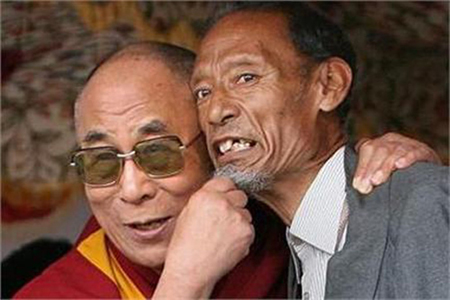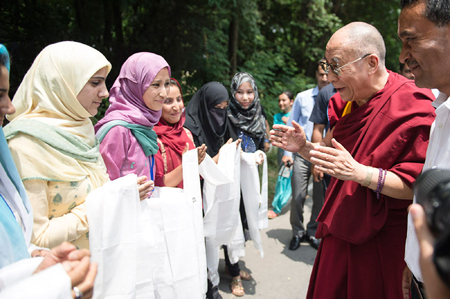The Tibetan Muslims living in Kashmir are now a mixed identity. They were ecstatic at seeing the Dalai Lama, their king, visit them in Srinagar recently. But, least bothered about the future of Tibet, they consider themselves Kashmiris and Indian citizens simultaneously, yearning for a resident status, reports Bilal Handoo

From the land of Lamas, the exiled spiritual leader of Tibetan people arrived in Kashmir to meet his exiled brethren after 24 years of patient waiting. It was the moment of joy for hundreds of Tibetan families living in Srinagar. Shining eyes and smile on their lips these families revealed a thousand stories of spiritual relief after meeting their King – the 14th Dalai Lama.
A reception was organised in Tibetan School, Hawal where the Chief Minister accompanied him along with his high officials. Kashmiris were rubbing shoulders with Tibetans which made the Dalai Lama to talk about communal harmony during his speech. “We should all strive to create a harmonious society where we will care for each other,” the Dalai Lama said.
Indo-Tibetans in Hawal area of downtown Srinagar rated this visit as satisfactory, although they don’t expect much out of it politically. “He is our leader and of course king for all of us and therefore he deserves our respect and love,” said Sameer Malik, a Tibetan youth.
The Tibetan community here sees the visit as more of a solidarity visit rather than a political one. During his stay here in Hawal, the Dalai Lama visited a mosque built by Tibetans and offered prayers there. He also relished wazwaan and momo, besides other dishes on the occasion.
This high profile visit was one of the prime occasions which put Indo-Tibetan community of Srinagar under the spot light once again. Living in Kashmir for last fifty years, this community enjoys a quiet existence here. Generally perceived as reticent, the Indo-Tibetans have had a traditionally strong relationship with and roots in Kashmir.
According to historical documents, spice merchants from Kashmir visited Tibet around 12th century AD. They settled there, married Tibetan women and converted them to Islam. Immigrants from Kashmir, Ladakh, China and Nepal form origin of the Tibetan Muslims as per popular beliefs.
This community is easily distinguishable from the rest of Kashmiris. Speaking broken Kashmiri, carrying Mongoloid facial features, adorning a unique culture and dresses are their apparent personality traits. They migrated from Tibet once it was invaded by China in 1950’s. In 1913, the Dalai Lama and the Tibetan National Assembly (TSANGDU) proclaimed Tibet’s independence, but China declined recognition and on October 7, 1950, about 40000 Chinese PLA troops attacked Chamdo, eastern Tibet’s provincial capital and defeated the Tibetan army after 12 days of fight. India Foreign Ministry sent a protest letter to Chinese government.
The Tibetan National Assembly requested the then 15-year-old Dalai Lama, Tenzin Gyatso, to assume full political control as Head of the State of Tibet in November 1950. Using military threat on May 23, China forced Tibetan delegations in Beijing to sign a 17-point agreement, which included that external affairs and defense of Tibet would lay with Chinese authorities.
Meanwhile, in 1956 the Dalai Lama visited India to discuss possible asylum and finally on March 10, Tibetan uprising in Lhasa against the Chinese brutality started and thousands were killed. On16 March 1959, the Dalai Lama left Potala Palace and came to India, accompanied by his mother, brother, two sisters and later his 72 companions also arrived.
Jawaharlal Nehru, the then Prime Minister swung into action and let Tibetans migrate to India. Before they could migrate, Chinese communist authorities levied different taxes on them and much of their property was seized and many of the Muslim religious leaders were given life imprisonment.
Faizullah Malik was just sixteen when he left Tibet with120 Muslim families. “We reached Kalimpong in Assam and then Darjeeling in West Bengal and resided there for five or six months,” he said. From Darjeeling around 70 families reached Kashmir. Idgah in Kashmir was their first camping spot here. He says the then Prime Minister of J&K, Bakhshi Ghulam Mohammad welcomed them wholeheartedly.
“We were housed in camps in Idgah and were later shifted to exhibition ground, Jehangir Chowk during winters and meanwhile Bakhshi Sahib constructed housing buildings for us in Idgah area of Srinagar,” he says.
The displacement of Tibetan Muslims happened in two phases; first in 1959 and the second time in the early 1980’s. As many as 85 Tibetans followed the footsteps of the Dalai Lama on March 16, 1959 during the first phase and 25,000 Tibetans crossed Indian borders during the second between 1986 and 1996 when Tibet was open for trade and tourism.
India received another batch of 2200 Tibetans in 1999 which was granted legal residence and were recognised as Indian citizens. The Indian government allows the entry of any Tibetan refugee on the Dalai Lama’s assurance that they personally abstain from violent and political activities. The democratic administration in exile was setup in Dharmshala, Himachal Pradesh.
A witness of this mass migration, Karimullah, 65, resident of Hawal, says that once China invaded Tibet, the Chinese authorities curbed religious practices of Tibetan people included Muslims. “Prayers were banned and mosques were locked by China and they also used these sacred places for wine parties,” he said.
He says that protests were held over these curbs, which only proved as a storm in a teacup. “Chinese authorities jabbed these protests with iron fist which resulted imprisonment, harassment and humiliation of leaders in public,” Karimullah said.
Muslim religious leaders too had to face this Chinese wrath which made many of them perish in the jails. Tibetan Muslims felt too choked and finally started moving out.

A request for migration was made to the then Indian ambassador to Tibet by the Muslim community which brought this matter before the Prime Minister of India. India gave its affirmative nod after the Dalai Lama sought shelter for himself and his people in India.
Since 1959, life of the Tibetan community in Kashmir has received many local influences. This community is undergoing change in cultural, educational and economical fronts. Issues related to land, proper housing, employment, stereotyping and discrimination are still felt by them. “If any of us owns a car today, then people around us start talking about the legitimacy of the same,” said Abdullah Bhat, 55, a Tibetan Muslim living in Idgah.
“We are basically Kashmiri, but people still call us Tibetans which hurts us,” said Abdul Wahab Shaguli, 70, a resident of Hawal. The resentment on being called Tibetan is common among the community now. They don’t consider themselves refugees in Kashmir.
Their exposure to two cultures, Kashmiri and Tibetan, has turned them into a unique community separate from both. They are not politically integrated in Kashmir.
The Tibetan Muslims living in Kashmir are not officially state subjects of this land, which compels them to live as semi-refugees here. They are not entitled to government jobs either. Tailoring and stitching are their main occupation. In their quest of sustaining their rising populace, they have already moved to other districts of Kashmir in search of better markets. “Like any other community, ours is also expanding sans any addition to space we presently live in,” said the elderly Wahab.
A majority of the Tibetan youth living in Kashmir engage in small businesses and tailoring, needle work, brocading and other embroidery works. They have also made business links in Nepal, Ladakh and other neighboring regions.
Most of the Tibetan Kashmiri families have embedded Kashmiri ethos in themselves and the Tibet political issue is hardly finds any resonance among them. “Even if tomorrow Tibet might be liberated from China, we will stay here only,” said 20 years old Irfan Trumboo.
Presently, this community is scattered in Hawal, Eidgah and Gulshan Colony of Makhdoom Sahib area. They are known for their communal brotherhood in these areas. ”They are very docile with healthy mentality and carry a sense of compassion,” said Showket Nazir, a Kashmiri neighbour of an Indo-Tibetan in Hawal.
Wearing an appearance of Tserings and Lamas of Ladakh, a majority of these Indo-Tibetans are educated, religious education is especially high among them. Most are Hafiz and Aalim, both high degrees in Islamic education. The Tibetan Public School in Hawal is their major educational institute. Literacy rate among this community in Srinagar is 61.33% according to a survey.
Tibetan marriages, festivals, and other rituals are distinctly Islamic, but this community is in a transition. Their youth are highly receptive to prevalent changes in lifestyle. “The fashion statement in Tibetan youth is at par with modals and cine stars,” says resident of Hawal.
In spite of merging with Kashmiri culture and ethos for decades now, the Tibetan Muslims have maintained their identity. Their Kashmiri names and surnames like Trumboo, Malik, Bhat, Shah etc have not diluted their distinct Tibetan cultural identity. However they yearn for domicile status in the state. They are marrying Kashmiri and Ladakhi girls to avail state benefits.
Some of them are now migrating to Nepal and other regions in search of a better life. “We are Indian nationals,” was the reply of group of Tibetan teenagers when asked about the Tibet political issue.















